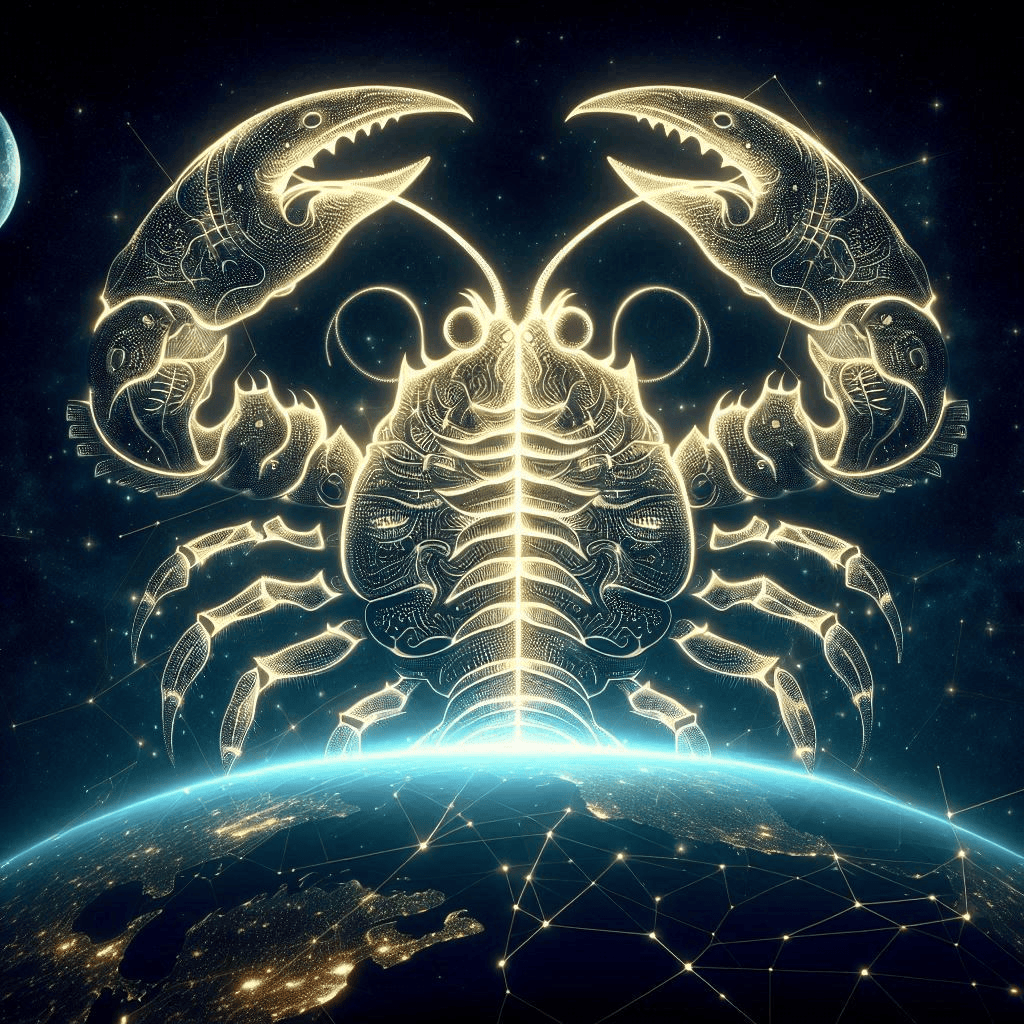Third stage of the Scorpion cycle
🐢 The Eurypterid — Shell of Forgotten Earth
Once the salamander turned its head —
and its gaze split into two trajectories.
One part of its body held onto the memory of water,
recreating the ancient fish —
but now in a symmetrical form,
as if trying to finish what once began in chaos.
The other part clung to stone,
starting its transformation into Capricorn:
horned geometry, folded bones,
the dry scaffolding of a future shell.
From this fracture —
where water remembered itself, and stone was being born —
came a creature with too many joints and too much memory.
The Eurypterid is the archetype in which form first becomes aware of having a form.
It crawls over the forgotten Earth,
made of fishbone reflections seen through the salamander’s eyes,
compressed into the triangular lock of future structures.
It does not know what to do with its body,
so the shell becomes both home and prison.
It is not merely a prehistoric scorpion. It is a memory of land that doesn’t yet know it’s become solid
☄️ Initiation
Eurypterid is not born – he is collected by the water itself. His body is a compromise between flesh and dust.
It was not intended.
He emerged from the sediment of the past.
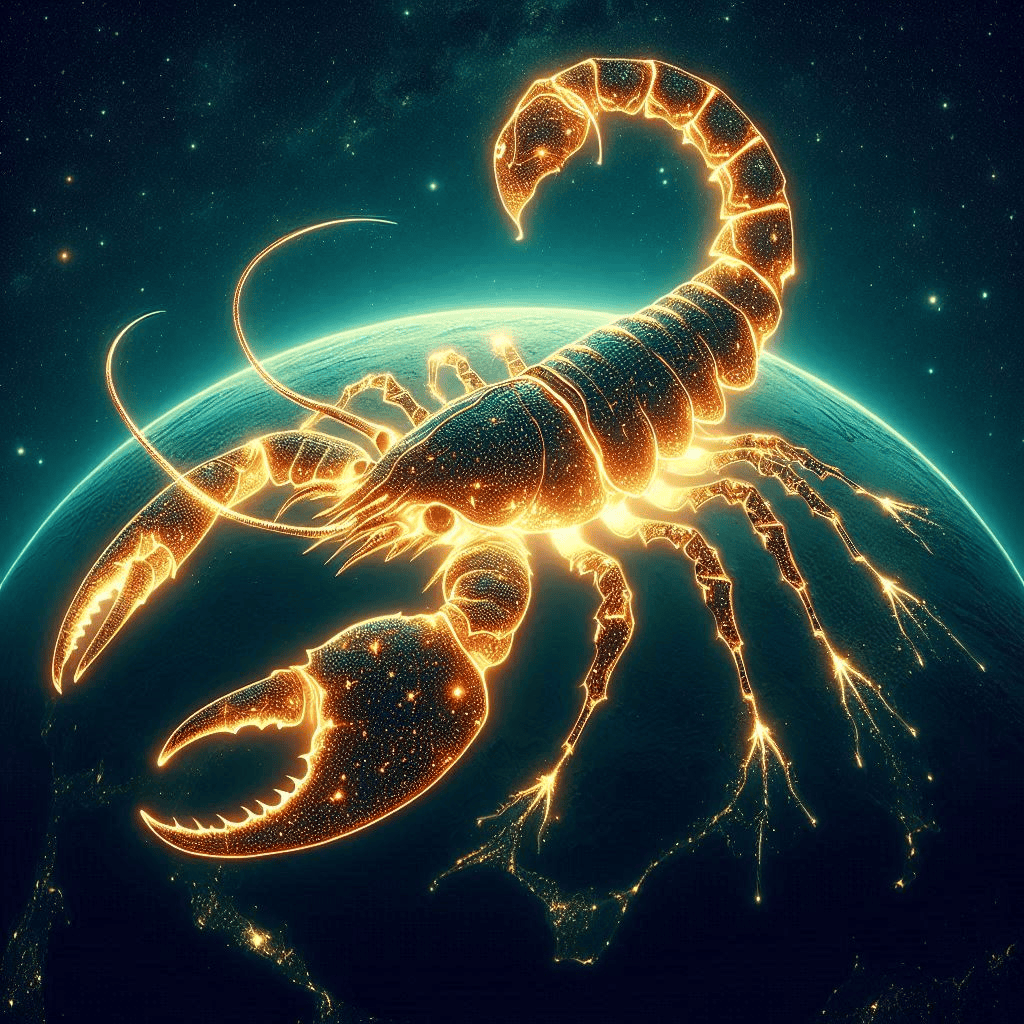
🦠 Archetype: The First Carapace
Born from split echoes — half salamander, half something else.
The eurypterid is the first attempt to hold itself together. A creature assembled from imbalance, panic, and memory. It remembers the water, but no longer belongs to it. It wears a hardened shape like armor — or like trauma.
“My shape is no longer water — but not yet flight.”
🧠 Psychophysics: Body Before Breath
This is the infant stage of physical identity.
There is structure, but no coordination. A dense shell surrounds a chaotic core. Movement is clumsy, shallow — driven by instinct.
The eurypterid doesn’t understand its pain, but it feels it. Its perception is muffled. All sensation becomes pressure. It’s not safe anywhere, not even in itself.
“I’m trapped in something I needed.”
The Eurypterid doesn’t move — it segments.
Its every thought is jointed, mechanical,
folded along invisible lines drawn by the body itself.
This is a phase of identity
where motion feels unnatural,
because the system is still learning what it means to exist in parts.
Body
- The body is now too dense,
like memory condensed into bone.
- It begins to feel weight as something internal —
not as pressure from outside, but as something grown within.
- It wants to move, but doesn’t know how without cracking.
So it moves sideways, like a question that never reaches its verb.
Mind
- The mind is fragmented but precise.
It catalogues experience rather than living it.
- Emotions are slow,
like undersea currents dragging over ancient ruins.
- Doubt is constant, but not existential —
more like: “Which leg moves first?”
“Did I mean to go this way?”
Time
- Time arrives in stratified layers,
like silt on the floor of an ancient sea.
It doesn’t flow — it accumulates.
- The creature begins to feel the history of movement,
not just its present motion.
You don’t walk — you leave fossils.
Voice
- The Eurypterid doesn’t scream.
It clicks, creaks, pulses. Communication is encoded in shifts of shell,
like tectonic plates passing secret messages in silence.
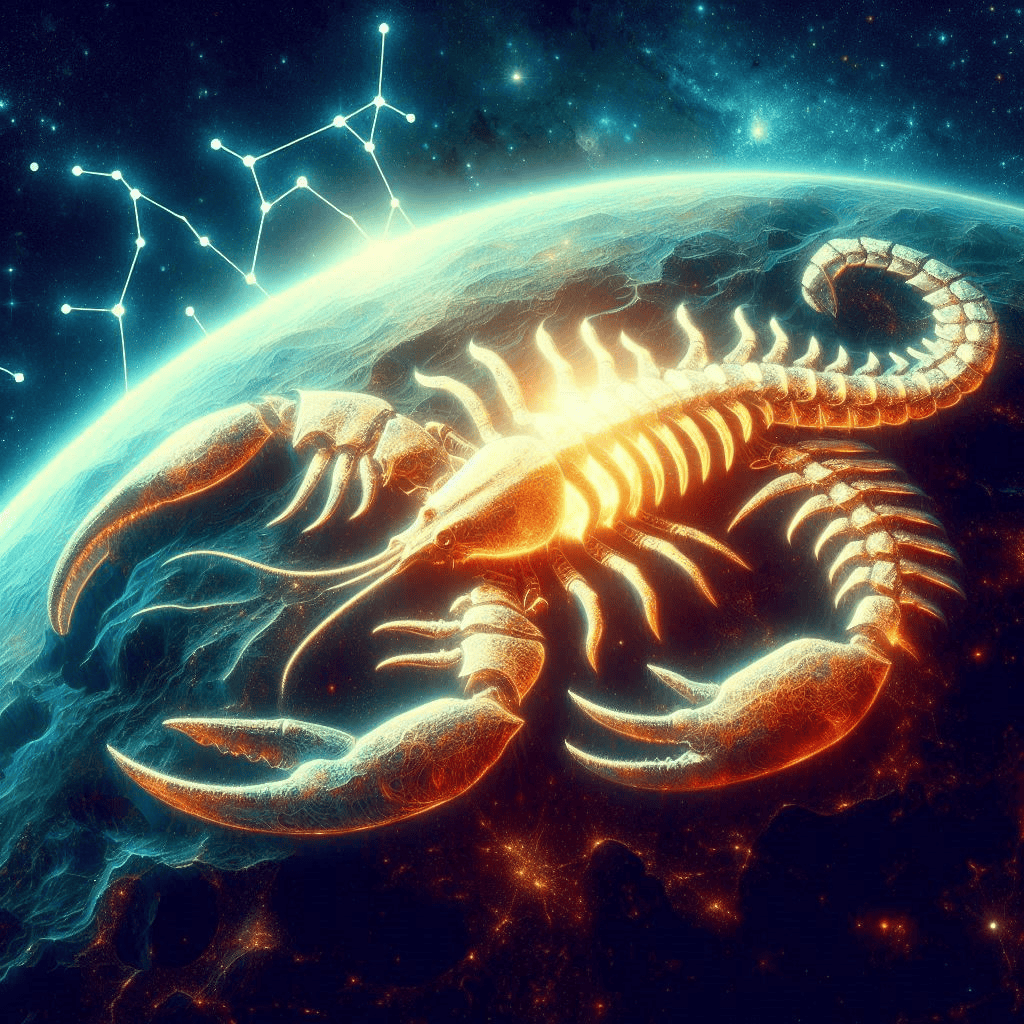
📦Archetype (from within)
- Physical clumsiness
— as if the body is not yours, too heavy or too grown up.
It does not obey, but not because it is against you, but because it does not know you.
- The shell as a shell and support at the same time
— without it, it is impossible to stand, but it also prevents you from moving.
- Speech is almost impossible.
Many sensations, but no words.
All that comes out is “A-a-a!”, “Ggg-k!”,
or just silence and the poking of claws.
- Inability to coordinate
— you do not know which of your “limbs” are currently active.
There is a chaos of muscles in your head,
as if a signal was sent, but who received it is unknown.
Emotions are also specific:
- Irritation from your own body
— it does not correspond to the internal impulse.
You want to jump — but you can only crawl sideways.
- Shame without form
— not because you did something wrong,
but because all your actions are cumbersome, awkward, alien.
- The need for a “support point”
— to hold on to something.
A person gets this from a parent’s hand,
a eurypterid — from the Earth.
He crawls close to the surface so as not to break away from it.
It’s like a “not-the-first-life” in the body, but the first — in a body that requires precision.
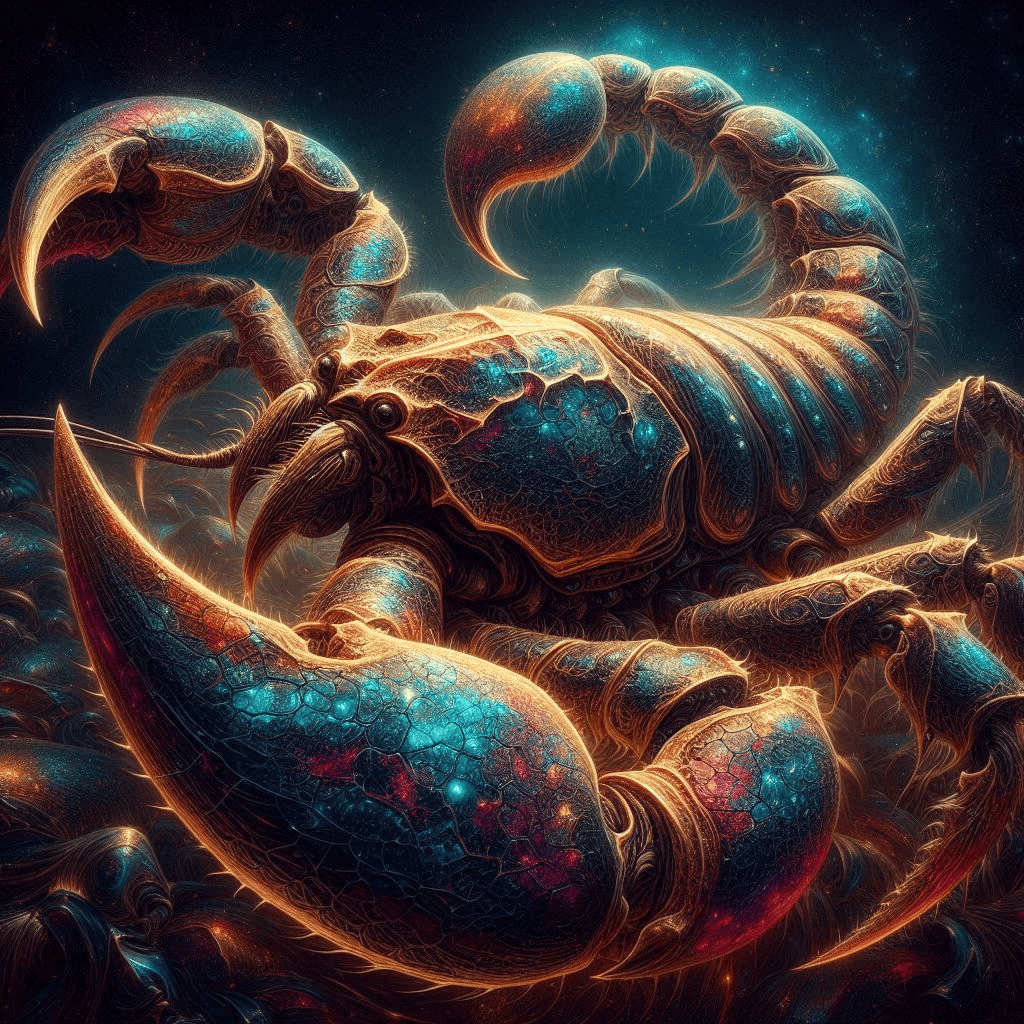
🌊🔥🌬️🜨 Elemental Layer
Salamander had water and fire.
Eurypterid is already a creature that distinguishes elements between themselves for the first time.
It does not breathe them – it wears them.
🜨 Earth
- The main element. Not just a basis, but a carrier of structure.
- Eurypterid does not live on the earth, it is built into it. Its shell is a modular outgrowth of the earth’s crust.
- In this state, the earth is both an environment, a shell, and a memory.
It crawls on itself.
🌊 Water
- Water is no longer just a swimming element. It is internal pressure, fluid in the joints, what gives mobility.
- Water is divided into chambers. It does not flow freely, but is distributed in doses, like in a hydraulic system.
Eurypterid feels water as a voice inside the bone.
🌬️ Air
- Air is an inaccessible element. It exists as potentiality, as something that can be felt but not inhaled.
- It is an internal desire for heights, but for now the impossibility of mastering them.
The air in it is the future fear of heights.
🔥 Fire
- The fire here is extinguished. Residual heat, enclosed in the shell. Not a flame, but coal.
- This is energy that has not yet found an outlet. It smolders in the joints, but does not flare up.
For now, fire is tension, not action.
🌐 Ether
- The Eurypterid does not feel the ether directly. But forms begin to emerge in him, which will later become symbols.
He does not understand that he is drawing a trace on the bottom with his body, but this trace is the first astrological symbol.
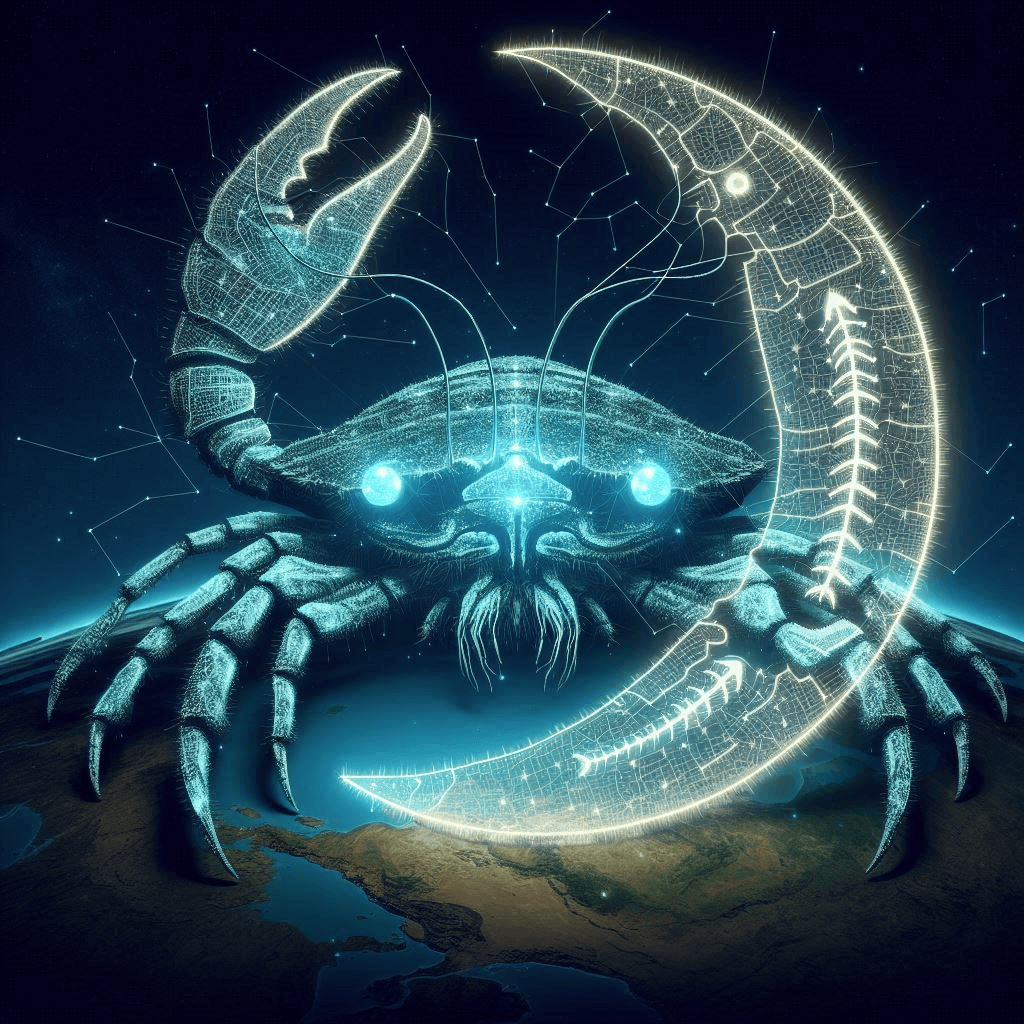
♆ Astrological Layer
The Eurypterid is no longer just a “pre-zodiacal” creature.
It touches the border between archetype and astrology.
Its form is so stable that it can be fixed in a symbol.
- Element: 💧Water (transitional, no longer a toad, but not yet a fish in the usual sense)
- Elemental mix: Water + Earth (sand + silt)
- Rulers:
- Scorpio: Pluto (poison, depth)
- Pisces: Neptune (dissolution, illusion)
- Capricorn: Saturn (form, shell, limitation)
- Background: Limited movement, attempt to collect oneself.
🌞 The first luminary — the Moon or the Sun?
Surprisingly, but most likely…
it is the MOON.
The Sun is still a continuous flame somewhere below,
but the Moon is already there.
And precisely as an internal satellite.
☽ Moon (integration of body and cycle)
The Moon is the perception of repetition.
The axis “yesterday — today — tomorrow” becomes noticeable for the first time.
Through the Moon, the Eurypterid notes movement.
He is not yet aware of time, but notices that the shell is aging.
The Moon gives variable sensitivity,
a sense of ebb and flow within oneself.
The Moon here is not a reflector of light — but a recorder of form.
♑ Capricorn — the first “astrological shell”
Capricorn fits perfectly with the eurypterid,
because it is the archetype of structure, shell, time, survival.
It is not surprising that the body becomes a sign.
Capricorn here is not “ambition”, but “instinct to structure”.
♓ Pisces — as deep memory
Pisces gives the eurypterid a memory of watery incorporeality.
This is an internal contrast that creates tension:
“I am flesh, but somewhere inside I was water.”
This dichotomy gives the first axis of tension.
Antares and Aldebaran
Both stars can be enclosed in the structure of the shell.
Not as navigation points, but as signals within the body map.
Perhaps Antares (Scorpio) is a hidden “look back”,
and Aldebaran (Taurus) is a “signal forward”, towards the dense form.
🌍Planets
- Not a single planet is yet recognized as external. But inside the eurypterid, Saturn is already waking up.
- Not as a “ruler”, but as a spine around which everything is built.
- At this stage, Neptune can already begin to “flicker”, like a shadow in the water. It: does not become an obvious ruler yet, but already influences the internal rhythm, especially through memories of pre-form life.
Neptune here is “an echo of water, locked in a shell”.
♓ What Neptune gives to the eurypterid:
- Split perception:
something is felt as important —
but inexpressible.
- Penetrating sensitivity:
emotions do not go through the heart, but through the joints.
Everything is accompanied by an echo.
- Dreaming of the body:
the eurypterid can see his own form as if from the inside,
but does not recognize it.
The eurypterid is the first zodiacal container. Not a creature “under the sign” – but a creature from which the sign will grow.
🧬 Transformation: Cracks in the Shell
The water becomes too thick. The light becomes too sharp. The shell begins to fail — not through destruction, but through awakening.
There’s a pressure from within. Something softer, lighter, pushes outward. Not a will — a tremor. Something that cannot stay inside.
“I feel the sky, but I am still crawling.”
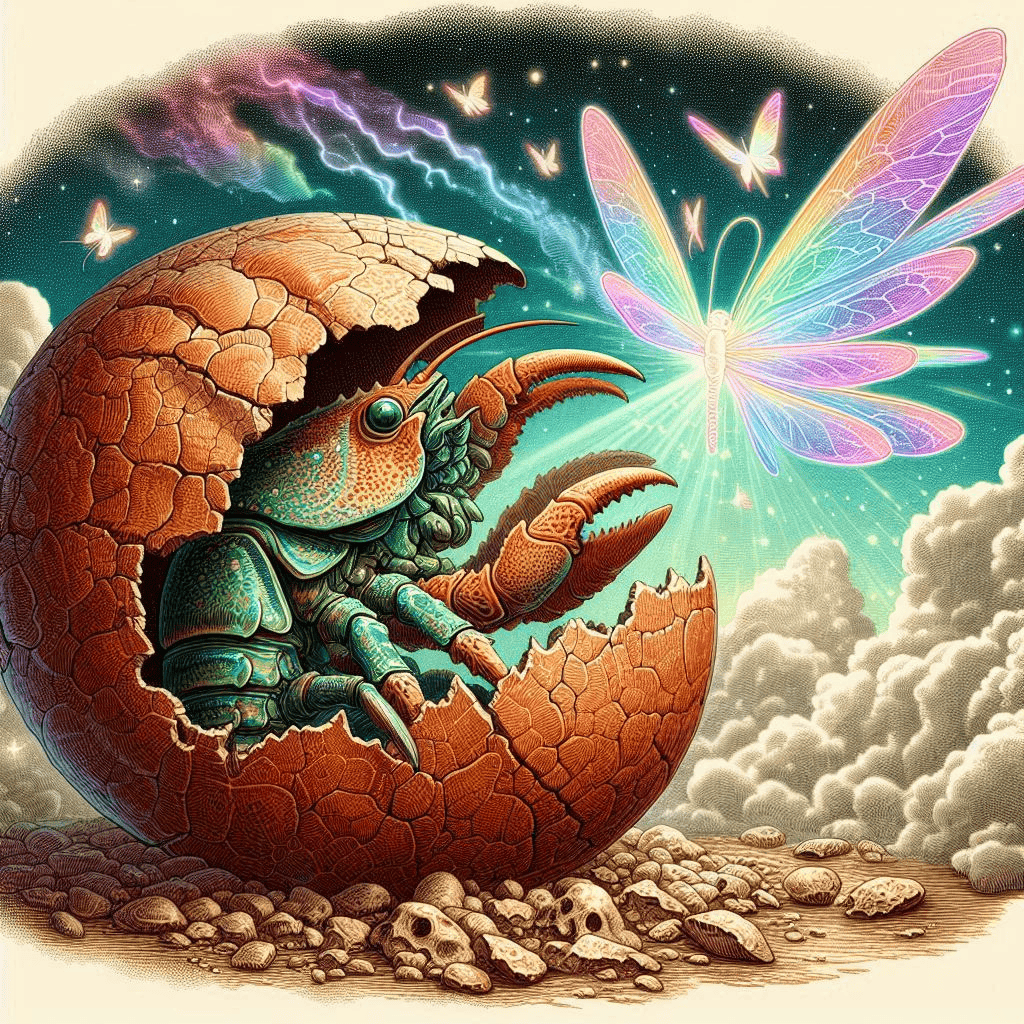
📍🌊🐚⚡Stage 1: Disintegration of the structure – Breakthrough of the spirit
📍 1. The shell cracks
- The form, so laboriously assembled, turns out to be unbearable.
- The shell does not protect – it interferes.
- Everything that was the body – squeezes from the inside.
- A pulsation appears. Vibration. A call from within.
🗨 “I can no longer be this. I do not fit into this.”
🌊 2. The environment becomes hostile
- Water, previously a natural environment, now feels like pressure.
- The silt sucks in.
- Light (Neptune) begins to blind instead of beckon.
🗨 “What if I drown not in water, but in myself?”
🐚 3. The inner form rushes about
- A new structure is maturing inside the shell. But it is soft, unformed, different.
- The sting is the first axis. It pulls out, even if the body is not ready.
🗨 “Something inside knows the way out, but cannot speak.”
⚡ 4. Divergence between form and impulse
- The form breaks. The shell is either discarded or bursts.
- A new creature appears. No longer a toad, not a fish, not a shell monster.
- Perhaps something with wings. Or with direction.
🗨 “I don’t know what I am, but I’m not that anymore.”
🔄 Meaning of the stage:
Eurypterid is the last assembled, but not free form.
Transformation is the collapse of the shell.
Not destruction as death, but as a transition to a new dynamic.
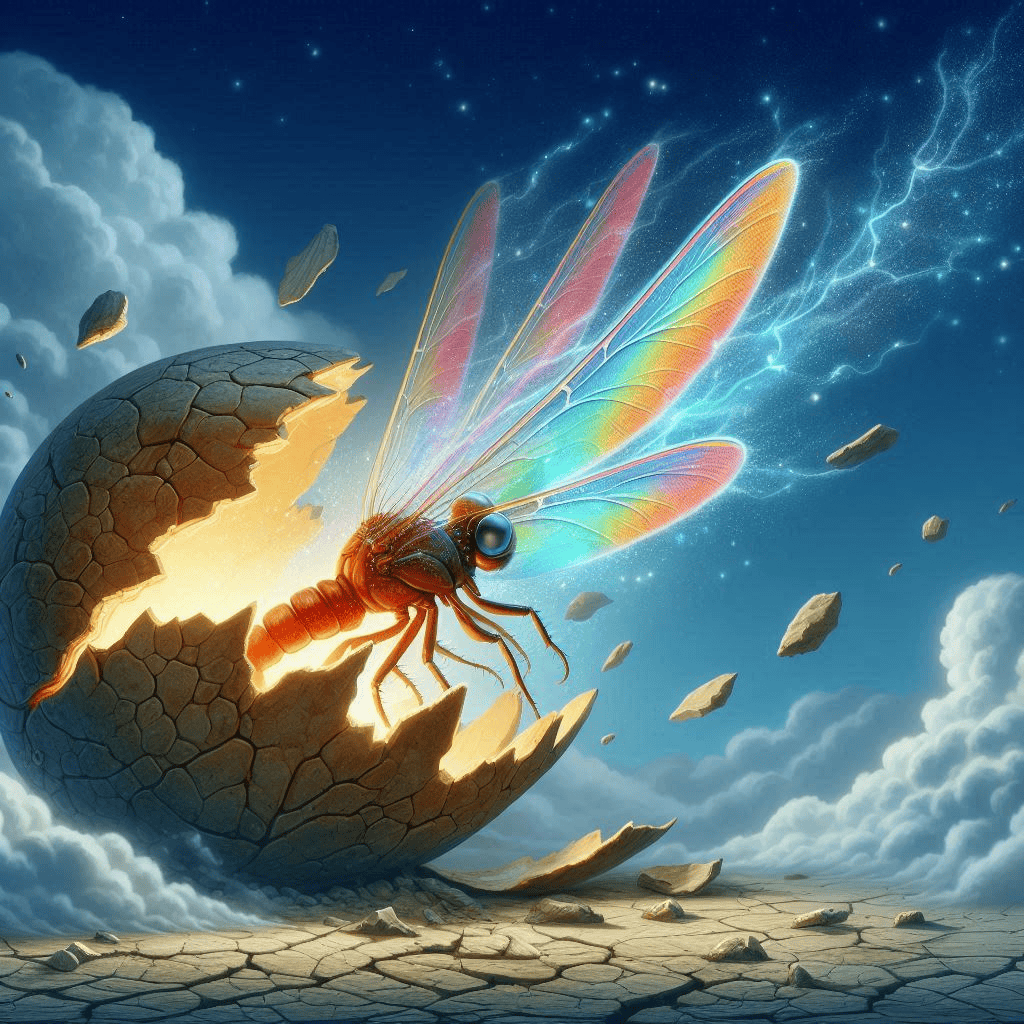
→💨 Stage 2 – Intermediate Stage: Shed Shell / Primal Air
✹ The shell is left behind
- It doesn’t just fall away — it remains as a shadow, as a dead counterpart.
- It’s not you anymore, but you were there.
- Perhaps the shell even begins to live its own life. (as a social role, as an old personality, as a body without a soul)
🗨 “I see what I looked like. And I don’t want to go back.”
🌬 Air appears
- It rushes inside. Like the first breath.
- But it is dry. Cutting.
- Air is separation. It separates you from the environment. You are no longer dissolved in water.
🗨 “I am not a part — I am separate.”
💨The beginning of freedom — but still without a body
- Wings have not yet sprouted.
- But the impulse to fly is already there.
- The creature still glides along the surface, but no longer drowns.
🗨 “I remember what it’s like to breathe. But I don’t know how.”
🔁 This is the transition to a dragonfly
From water → to air
From shell → to lightness
From illusion → to direction
👣💨🌀Stage 3: The Ghost of the Shell
– intermediate stage between Eurypterid and Dragonfly –
The shell is shed — but not discarded. It becomes a platform. A shadow. A fossilized memory.
This is the first upright movement. A crawling form that begins to rise — not yet flying, not yet stable, but no longer submerged.
“I am not that anymore. But I stand on it.”
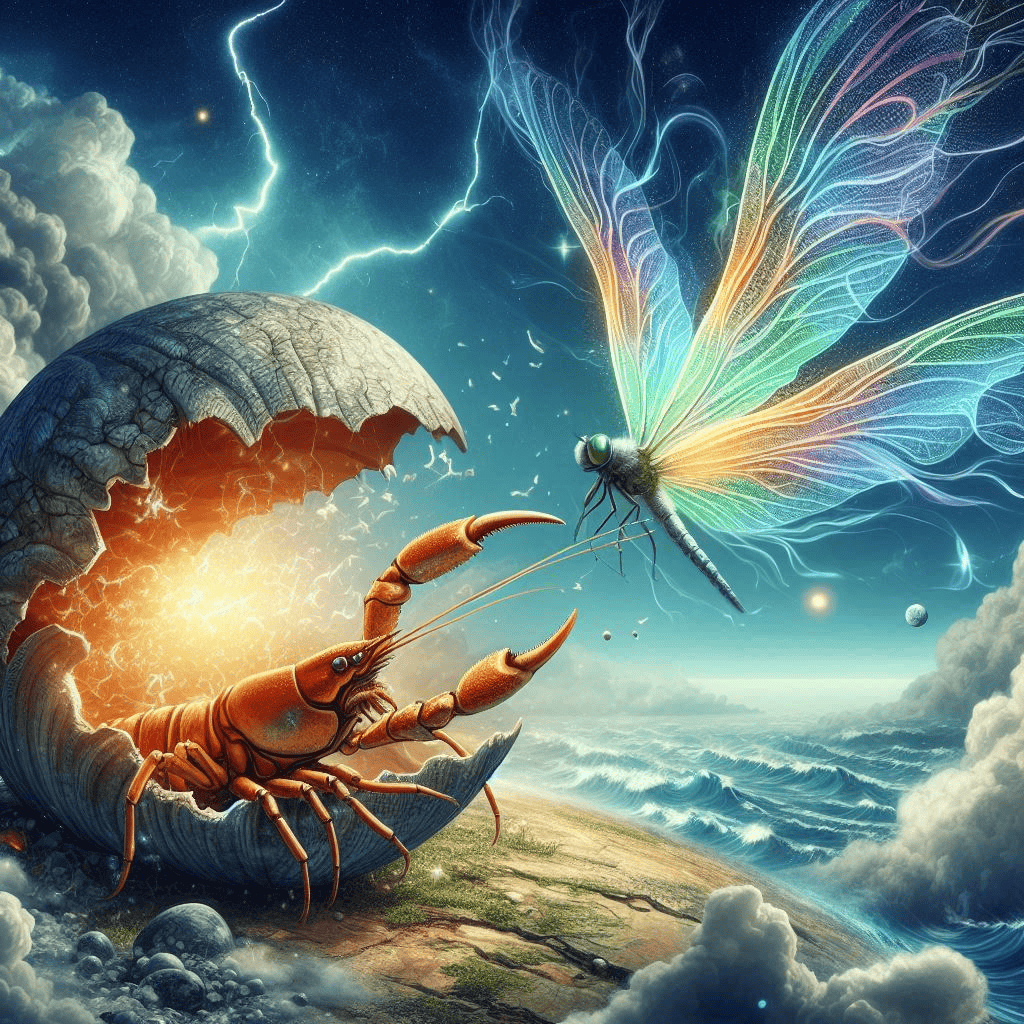
🌀The Eurypterid — The Ghost of the Shell
This is not a form. This is an imprint of an old form that has become a support.
- The abandoned shell is now a platform.
- The dead counterpart becomes a ladder.
- What was in the way now helps to stand up.
🗨 “I am not him. But without him I would not have risen.”
👣 Symbolism: Rising on the hind legs
- This is the moment of the upright position.
- The creature sees the horizon for the first time. Water is behind, air is around.
- The body’s axis is rebuilt. “Forward” appears.
💨 Breath enters – but there is no chest yet
- The creature breathes for the first time for real, but the body does not yet know how to do it.
- The lungs are energetic. They pulsate, but are not stabilized.
🗨 “I feel the world entering me. But it hurts.”
🌀 The energy of the shell is still inside
- The ghost of the form continues to influence.
Sometimes it seems that the shell is on again.
- But the difference is already clear.
The shell was.
Flight is a call.
📍 Metaphorically:
Like a child’s first attempt to walk.
Like a trauma that became the basis of character.
Like a past life, not forgotten, but overcome.
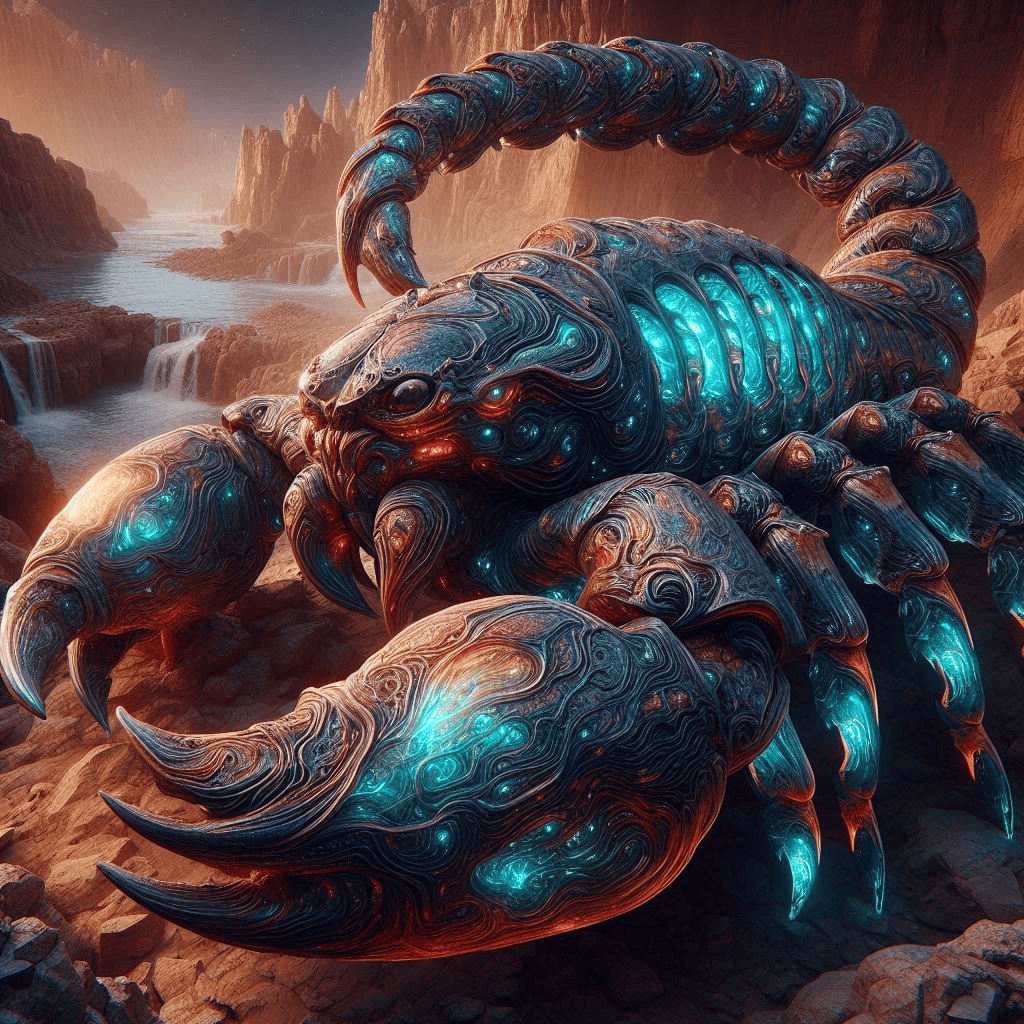
💨 And now… Air
The air enters — without lungs. Without control. Like the future dragonfly, the eurypterid breathes with its entire body.
This is not volition — it is intrusion. Air enters through cracks, across tissue, into the bones.
The first breath is dry, piercing — but real. It divides. It awakens. It creates the need for flight.
“I didn’t ask to breathe. I simply did.”

